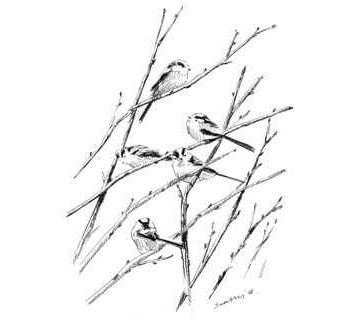
Long-tailed Tits © Ray Scally
The Atlas maps show that Long-tailed Tits do move somewhat to occupy extra tetrads in winter, and become the eleventh most widespread winter species. 573 tetrads have birds in breeding and winter seasons, with 49 tetrads having birds in winter only, and 20 had breeding season presence but no winter record. The areas filled in during winter include some of the county’s most inhospitable tetrads, five in the highest hills and five in urban east Wirral. Most of our birds appear to be resident or make short distance movements, but some do undertake longer journeys, including a flock of three juveniles, ringed together in June 1981 in Warwickshire and retrapped together on 14 February 1982 at Caldy, 142 km northwest.
As this record suggests, these gregarious birds spend most of their lives together, seldom seeming to be more than one or two bushes apart from each other. The groups are usually family parties, comprising a brood, its parents and any extra adults that helped to raise that brood. Over the three years, 663 Atlas records included counts of flock sizes: 30% of them held more than ten birds, but only 2% were above 20 in size. The numbers in the larger flocks are difficult to estimate, but on 17 February 2001 I mist-netted two flocks totalling 55 birds going to roost in areas of bramble and rhododendron only 100 metres apart from each other.
The winter flocks are generally territorial, holding an average area of around 20 ha, with larger flocks maintaining larger territories (Glen & Perrins 1988). With such large areas, the birds in one flock do not often come into contact with those in another, but when they do, they defend their boundary vigorously. Long-tailed Tits also roost together, low down in a dense thorny bush. This is one of the few British species where the communally roosting birds actually huddle together for warmth on cold winter nights, perhaps the reason that they stay in parties throughout the winter. Nonetheless, winter survival is often difficult for small birds, and prolonged periods of hard weather have hit the species hard in the past, as Bell (1962) noted, but the mild winters of the last decade or more have allowed populations to flourish.
Analysis of the habitat codes shows significant shifts between breeding and winter seasons. Woodland is still the most favoured but far fewer birds were reported from scrub (7% of records in winter, 17% during the breeding season) and farmland (7% of records in winter, 13% during the breeding season). Instead, birds are found much more in hedges (25% of records in winter, 16% during the breeding season) and in human sites (22% of records in winter, 17% during the breeding season). These changes indicate that birds are preferentially using the warmer and less windswept areas, where they can keep themselves warmer and are more likely to find insects. Long-tailed Tits are usually insectivorous all year round, although some birds in gardens do learn to feed on peanuts and suet.
Sponsored by Tony and Margaret Hayter

